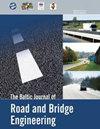静态和动态板载试验确定变形模量的实验研究
IF 1.1
4区 工程技术
Q4 ENGINEERING, CIVIL
引用次数: 6
摘要
土或土结构变形模量是公路、铁路、跑道和路堤等道路工程和交通基础设施设计的主要设计参数之一。它也是土壤改良的主要标准。当创建具有规范设计阻力的任何道路结构时,人们使用一定厚度和变形模量的结构层。两个值都需要满足符合法规要求的最小值。本文分析了在工程实践中广泛应用的确定土刚度的相关方法。公认的静态试验方法对于确定主要和次要载荷的变形模量是足够精确的。由于动态测试方法需要较少的时间和财力,因此在工程实践中被广泛接受。动力方法只确定变形的动力模量。设计实践旨在将其与二次荷载的静变形模量联系起来。许多国家提出以不同程度的保守性编纂相关性,将动态变形模量转换为静态变形模量。本文介绍了静板荷载试验结果与根据不同土的试验结果进行的动板荷载试验结果之间发展的相关性,并与其他提出的相关性进行了比较分析。本文章由计算机程序翻译,如有差异,请以英文原文为准。
Experimental Study of the Modulus of Deformation Determined by Static and Dynamic Plate Load Tests
Soil, or soil structure modulus of deformation, is one of the main design parameters for road engineering and traffic infrastructure design of, for example, highways, railways, runways and embankments. It is also the main soil improvement criterion. When creating any road structure with codified design resistance, one employs structural layers of certain thicknesses and modulus of deformation. Both values need to satisfy the minimum values in accordance with codified requirements. This paper analyzes correlations for the widely applied in engineering practice methods to determine the soil stiffness. The static test methods acknowledged to be exact enough for determining the modulus of deformation for the primary and secondary loadings. As dynamic test methods require significantly less time and financial resources, they are widely accepted in engineering practice. The dynamic methods determine only the dynamic modulus of deformation. Design practice aims to relate it with the static modulus of deformation of the secondary loading. Many countries propose codified correlations, with differing levels of conservatism, to convert the dynamic modulus of deformation into the static one. Developed correlations between the results of the static plate load test and the dynamic plate load tests processed from own test results of different soils are presented and a comparative analysis with other proposed correlations is given.
求助全文
通过发布文献求助,成功后即可免费获取论文全文。
去求助
来源期刊
CiteScore
2.10
自引率
9.10%
发文量
25
审稿时长
>12 weeks
期刊介绍:
THE JOURNAL IS DESIGNED FOR PUBLISHING PAPERS CONCERNING THE FOLLOWING AREAS OF RESEARCH:
road and bridge research and design,
road construction materials and technologies,
bridge construction materials and technologies,
road and bridge repair,
road and bridge maintenance,
traffic safety,
road and bridge information technologies,
environmental issues,
road climatology,
low-volume roads,
normative documentation,
quality management and assurance,
road infrastructure and its assessment,
asset management,
road and bridge construction financing,
specialist pre-service and in-service training;

 求助内容:
求助内容: 应助结果提醒方式:
应助结果提醒方式:


